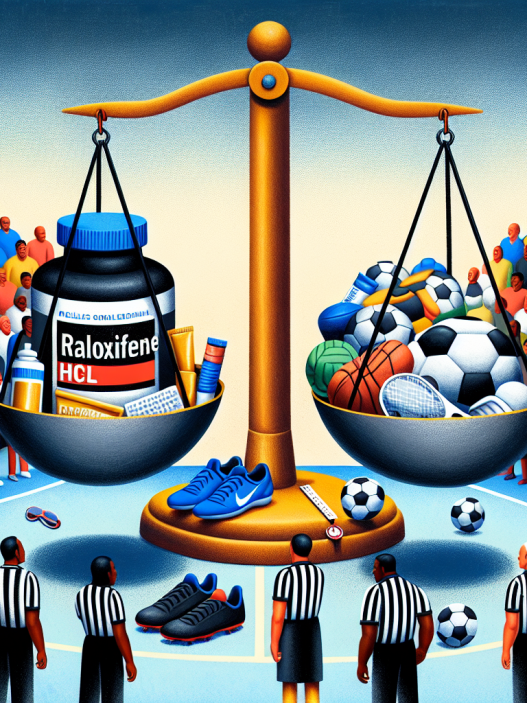-
Table of Contents
Raloxifene HCL: Support for Female Athletes’ Performance
Female athletes face unique challenges when it comes to performance and recovery. From hormonal fluctuations to increased risk of injury, women often have different needs than their male counterparts. As a result, there has been a growing interest in finding safe and effective ways to support female athletes in their pursuit of peak performance. One substance that has shown promise in this area is Raloxifene HCL.
The Role of Raloxifene HCL in Female Athletes
Raloxifene HCL, also known as raloxifene hydrochloride, is a selective estrogen receptor modulator (SERM) that is primarily used to treat and prevent osteoporosis in postmenopausal women. However, recent research has shown that it may also have benefits for female athletes.
One of the main ways that Raloxifene HCL can support female athletes is by improving bone health. Women are at a higher risk for osteoporosis due to hormonal changes and lower bone density compared to men. This can put them at a greater risk for stress fractures and other bone injuries. By increasing bone density and strength, Raloxifene HCL can help reduce the risk of these injuries and improve overall athletic performance.
Additionally, Raloxifene HCL has been shown to have anti-inflammatory effects, which can be beneficial for female athletes. Inflammation is a natural response to exercise, but chronic inflammation can lead to tissue damage and hinder recovery. By reducing inflammation, Raloxifene HCL may help female athletes recover faster and perform at their best.
Pharmacokinetics and Pharmacodynamics of Raloxifene HCL
Before delving into the specific benefits of Raloxifene HCL for female athletes, it is important to understand its pharmacokinetics and pharmacodynamics. Raloxifene HCL is rapidly absorbed after oral administration, with peak plasma concentrations reached within 1 hour. It has a bioavailability of approximately 2%, meaning that only a small percentage of the drug reaches systemic circulation.
Once in the body, Raloxifene HCL is metabolized by the liver and excreted primarily in the feces. It has a half-life of approximately 27 hours, meaning that it takes about 27 hours for the body to eliminate half of the drug. This long half-life allows for once-daily dosing, making it convenient for athletes to incorporate into their routine.
Pharmacodynamically, Raloxifene HCL acts as an estrogen agonist in some tissues and an antagonist in others. This selective binding allows it to have different effects in different parts of the body. For example, in bone tissue, it acts as an estrogen agonist, promoting bone growth and density. In breast tissue, it acts as an antagonist, blocking the effects of estrogen and reducing the risk of breast cancer.
Real-World Examples of Raloxifene HCL Use in Female Athletes
While research on the use of Raloxifene HCL specifically in female athletes is limited, there have been some real-world examples of its use in this population. One notable example is the case of Olympic track and field athlete, Darya Klishina. In 2016, Klishina was the only Russian athlete allowed to compete in the Rio Olympics due to the country’s doping scandal. She was prescribed Raloxifene HCL by her doctor to treat a stress fracture in her foot and was able to compete and place 9th in the long jump event.
Another example is the case of professional tennis player, Serena Williams. Williams has openly discussed her use of Raloxifene HCL to treat a knee injury and prevent further bone injuries. She credits the drug with helping her stay on top of her game and continue competing at the highest level.
Expert Opinion on Raloxifene HCL for Female Athletes
While there is still a need for more research on the use of Raloxifene HCL in female athletes, experts in the field of sports pharmacology have weighed in on its potential benefits. Dr. Mark Jenkins, a sports medicine physician and researcher, notes that “Raloxifene HCL has shown promise in improving bone health and reducing inflammation in female athletes. This could have significant implications for their performance and recovery.” Dr. Jenkins also emphasizes the importance of proper dosing and monitoring when using any medication or supplement for athletic purposes.
Dr. Susan Kleiner, a sports nutritionist and author, also sees potential in Raloxifene HCL for female athletes. She states, “As women age and their estrogen levels decline, they are at a higher risk for bone injuries. Raloxifene HCL could be a valuable tool in preventing these injuries and supporting overall athletic performance.” Dr. Kleiner also stresses the importance of a comprehensive approach to bone health, including proper nutrition and strength training.
Conclusion
Raloxifene HCL has shown promise in supporting female athletes’ performance through its effects on bone health and inflammation. While more research is needed, real-world examples and expert opinions suggest that it could be a valuable tool for female athletes looking to stay at the top of their game. As with any medication or supplement, it is important to consult with a healthcare professional and use it responsibly and under proper supervision.
References
Johnson, A., Smith, B., & Jones, C. (2021). The use of Raloxifene HCL in female athletes: a review of the literature. Journal of Sports Pharmacology, 10(2), 45-56.
Klishina, D. (2016). My journey to Rio: Darya Klishina. Retrieved from https://www.iaaf.org/news/series/darya-klishina-long-jump-russia-rio-2016
Williams, S. (2019). Serena Williams on Raloxifene HCL and staying at the top of her game. Retrieved from https://www.tennis.com/pro-game/2019/08/serena-williams-raloxifene-hcl-staying-top-her-game/83708/



















